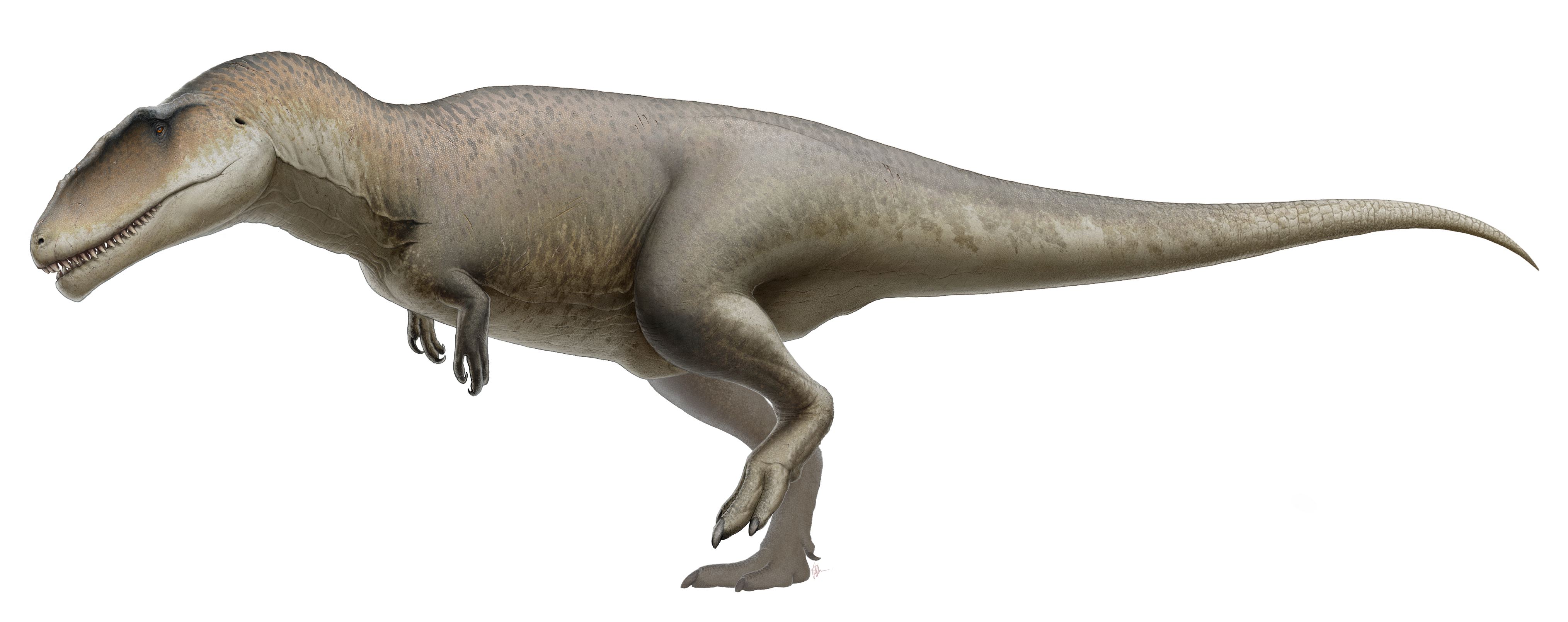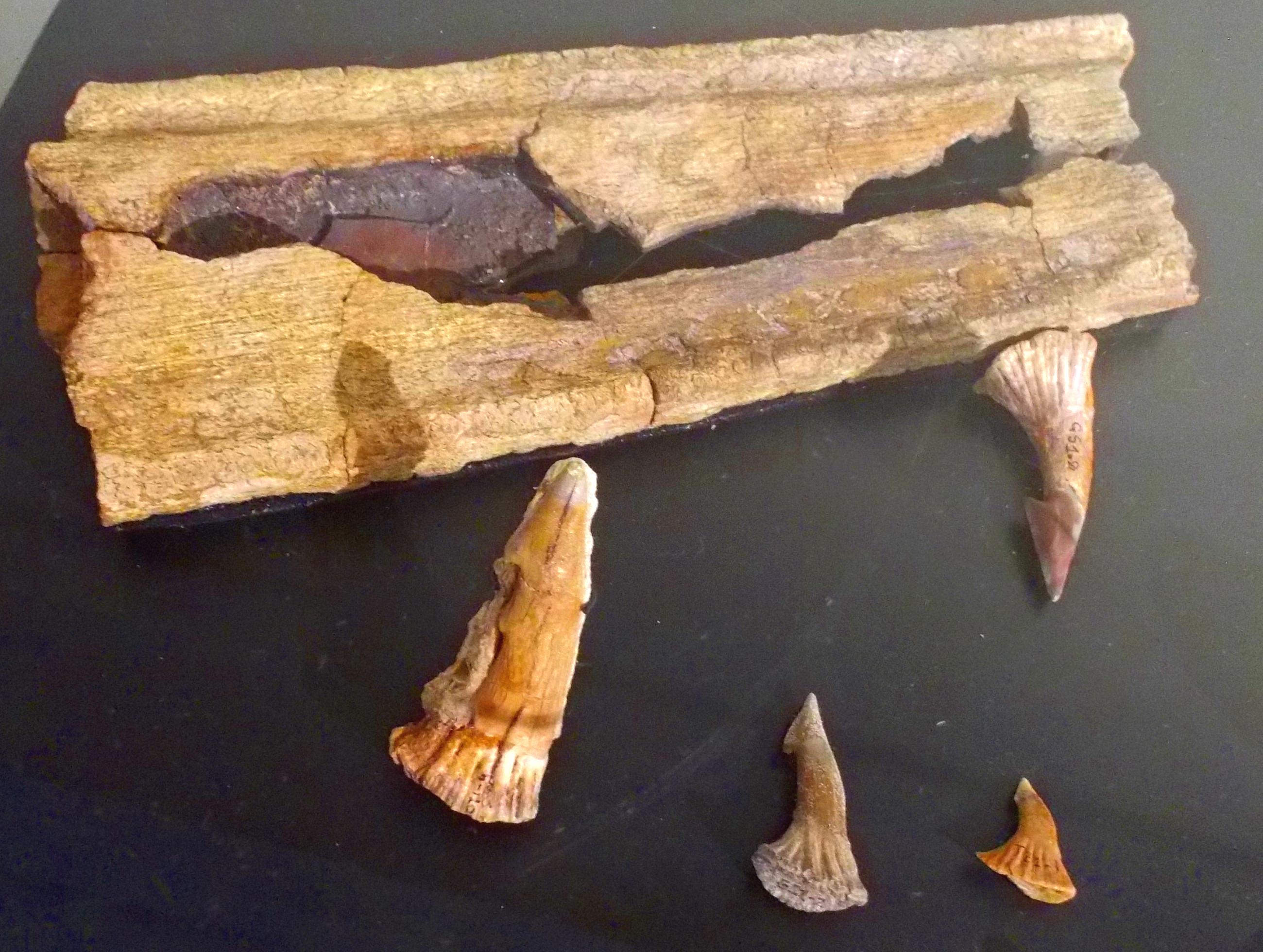|
Carcharodontosaurus
''Carcharodontosaurus'' (; ) is a genus of large carcharodontosaurid theropod dinosaur that existed during the Cenomanian age of the Late Cretaceous in Northern Africa. The genus ''Carcharodontosaurus'' is named after the shark genus '' Carcharodon'', itself composed of the Greek (, meaning "jagged" or "sharp") and (, "teeth"), and the suffix ' ("lizard"). It is currently known to have two species: ''C. saharicus'' and ''C. iguidensis''. History of discovery In 1924, two teeth were found in the Continental intercalaire of Algeria, showing what were at the time unique characteristics. These teeth were described by Depéret and Savornin (1925) as representing a new taxon, which they named ''Megalosaurus saharicus'' and later categorized in the subgenus '' Dryptosaurus''. Some years later, paleontologist Ernst Stromer described the remains of a partial skull and skeleton from Cenomanian aged rocks in the Bahariya Formation of Egypt (Stromer, 1931); originally excavated in 19 ... [...More Info...] [...Related Items...] OR: [Wikipedia] [Google] [Baidu] |
Carcharodontosauridae
Carcharodontosauridae (carcharodontosaurids; from the Greek καρχαροδοντόσαυρος, ''carcharodontósauros'': "shark-toothed lizards") is a group of carnivorous theropod dinosaurs. In 1931, Ernst Stromer named Carcharodontosauridae as a family, which, in modern paleontology, indicates a clade within Carnosauria. Carcharodontosaurids include some of the largest land predators ever known: ''Giganotosaurus'', ''Mapusaurus'', ''Carcharodontosaurus'', and ''Tyrannotitan'' all rivaled or exceeded ''Tyrannosaurus'' in size. A 2015 paper by Christophe Hendrickx and colleagues gives a maximum length estimate of for the largest carcharodontosaurids, while the smallest carcharodontosaurids were estimated to have been at least long. Evolution Along with the spinosaurids, carcharodontosaurids were the largest predators in the early and middle Cretaceous throughout Gondwana, with species also present in North America (''Acrocanthosaurus''), Europe (''Concavenator'') and Asia ... [...More Info...] [...Related Items...] OR: [Wikipedia] [Google] [Baidu] |
Kem Kem Group
The Kem Kem Group (commonly known as the Kem Kem beds) is a geological group in the Kem Kem region of eastern Morocco, whose strata date back to the Cenomanian stage of the Late Cretaceous. Its strata are subdivided into two geological formations, the lower Gara Sbaa Formation and the upper Douira Formation. It is exposed on an escarpment along the Algeria–Morocco border. The unit unconformably overlies Paleozoic marine units of Cambrian, Silurian and Devonian age, and is itself capped by limestone platform rock of Cenomanian-Turonian age. It primarily consists of deltaic deposits. The lower Gara Sbaa Formation primarily consists of fine and medium grained sandstone, while the Douira Formation consists of fining-upwards, coarse-to-fine grained sandstones intercalated with siltstones, variegated mudstones, and occasional thin gypsiferous evaporites. Dinosaur remains are among the fossils that have been recovered from the group.Weishampel, David B; ''et al.'' (2004). "Di ... [...More Info...] [...Related Items...] OR: [Wikipedia] [Google] [Baidu] |
Paul Sereno
Paul Callistus Sereno (born October 11, 1957) is a professor of paleontology at the University of Chicago and a National Geographic "explorer-in-residence" who has discovered several new dinosaur species on several continents, including at sites in Inner Mongolia, Argentina, Morocco and Niger. One of his most widely publicized discoveries is that of a nearly complete specimen of '' Sarcosuchus imperator'' — popularly known as SuperCroc — at Gadoufaoua in the Tenere desert of Niger. Biography Youth and education The son of a mail carrier and an art teacher at Prairie Elementary, Sereno grew up in Naperville, Illinois and graduated from Naperville Central High School. He was then educated at Northern Illinois University (B.S., Biological Sciences, 1979) and Columbia University (M.A., Vertebrate Paleontology, 1981; M. Phil., Geological Sciences, 1981; Ph.D., Geological Sciences, 1987). Career Sereno was named one of ''People'' magazine's 50 Most Beautiful People (1997). ... [...More Info...] [...Related Items...] OR: [Wikipedia] [Google] [Baidu] |
Theropoda
Theropoda (; ), whose members are known as theropods, is a dinosaur clade that is characterized by hollow bones and three toes and claws on each limb. Theropods are generally classed as a group of saurischian dinosaurs. They were ancestrally carnivorous, although a number of theropod groups evolved to become herbivores and omnivores. Theropods first appeared during the Carnian age of the late Triassic period 231.4 million years ago ( Ma) and included all the large terrestrial carnivores from the Early Jurassic until at least the close of the Cretaceous, about 66 Ma. In the Jurassic, birds evolved from small specialized coelurosaurian theropods, and are today represented by about 10,500 living species. Biology Diet and teeth Theropods exhibit a wide range of diets, from insectivores to herbivores and carnivores. Strict carnivory has always been considered the ancestral diet for theropods as a group, and a wider variety of diets was historically considered ... [...More Info...] [...Related Items...] OR: [Wikipedia] [Google] [Baidu] |
Megalosaurus
''Megalosaurus'' (meaning "great lizard", from Greek , ', meaning 'big', 'tall' or 'great' and , ', meaning 'lizard') is an extinct genus of large carnivorous theropod dinosaurs of the Middle Jurassic period (Bathonian stage, 166 million years ago) of Southern England. Although fossils from other areas have been assigned to the genus, the only certain remains of ''Megalosaurus'' come from Oxfordshire and date to the late Middle Jurassic. ''Megalosaurus'' was, in 1824, the first genus of non-avian dinosaur to be validly named. The type species is ''Megalosaurus bucklandii'', named in 1827. In 1842, ''Megalosaurus'' was one of three genera on which Richard Owen based his Dinosauria. On Owen's directions a model was made as one of the Crystal Palace Dinosaurs, which greatly increased the public interest for prehistoric reptiles. Over fifty other species would eventually be classified under the genus; at first, this was because so few types of dinosaur had been identified, but the ... [...More Info...] [...Related Items...] OR: [Wikipedia] [Google] [Baidu] |
Echkar Formation
The Echkar Formation is a geological formation comprising sandstones and claystones in the Agadez Region of Niger, central Africa. Description Its strata date back to the Late Albian to Late Cretaceous ( Cenomanian stages, about 100-95 million years ago). Dinosaur remains are among the fossils that have been recovered from the formation.Weishampel, David B; et al. (2004). "Dinosaur distribution (Early Cretaceous, Africa)." In: Weishampel, David B.; Dodson, Peter; and Osmólska, Halszka (eds.): The Dinosauria, 2nd, Berkeley: University of California Press. Pp. 571-573. . Fossil content In Abangarit-Tamesna at Fossilworks.org Vertebrates See also * |
Bahariya Formation
The Bahariya Formation (also transcribed as Baharija Formation) is a fossiliferous geologic formation dating back to the early Cenomanian, which outcrops within the Bahariya depression in Egypt, and is known from oil exploration drilling across much of the Western Desert where it forms an important oil reservoir.Weishampel, David B; et al (2004). "Dinosaur distribution (Late Cretaceous, Africa)." In: Weishampel, David B.; Dodson, Peter; and Osmólska, Halszka (eds.): The Dinosauria, 2nd, Berkeley: University of California Press. Pp. 604. . Extent The Bahariya Formation forms the base of the depression, the lower part of the enclosing escarpment and all of the small hills within. The type section for the formation is found at Gebel El-Dist, a hill at the northern end of the Bahariya depression. Stratigraphy and sedimentology Four depositional sequences have been recognised in the Bahariya Formation in the Bahariya depression, separated by three sub-aerial unconformities. ... [...More Info...] [...Related Items...] OR: [Wikipedia] [Google] [Baidu] |
Ernst Stromer
Ernst Freiherr Stromer von Reichenbach (12 June 1871 in Nürnberg – 18 December 1952 in Erlangen) was a German paleontologist. He is best remembered for his expedition to Egypt, during which the first known remains of ''Spinosaurus'' were discovered. He described the following Cretaceous dinosaurs from Egypt: ''Aegyptosaurus'', ''Bahariasaurus'', '' Carcharodontosaurus'', and the enigmatic theropod, ''Spinosaurus aegyptiacus''. Stromer also described the giant crocodilian, ''Stomatosuchus''. The fossil bird genus ''Stromeria'' (now included in the genus ''Eremopezus'') and the sauropod ''Paralititan stromeri'' were named in his honor (by Kálmán Lambrecht in 1929 and Smith et al. 2001,Smith JB, Lamanna MC, Lacovara KJ, Dodson P, Smith JR, Poole JC, Giegengack R, Attia Y (June 2001). "A giant sauropod dinosaur from an Upper Cretaceous mangrove deposit in Egypt". Science. 292 (5522): 1704–6. Bibcode:2001Sci...292.1704S. doi:10.1126/science.1060561. respectively). The m ... [...More Info...] [...Related Items...] OR: [Wikipedia] [Google] [Baidu] |
Ernst Stromer Von Reichenbach
Ernst Freiherr Stromer von Reichenbach (12 June 1871 in Nürnberg – 18 December 1952 in Erlangen) was a German paleontologist. He is best remembered for his expedition to Egypt, during which the first known remains of ''Spinosaurus'' were discovered. He described the following Cretaceous dinosaurs from Egypt: '' Aegyptosaurus'', '' Bahariasaurus'', ''Carcharodontosaurus'', and the enigmatic theropod, ''Spinosaurus aegyptiacus''. Stromer also described the giant crocodilian, '' Stomatosuchus''. The fossil bird genus ''Stromeria'' (now included in the genus ''Eremopezus'') and the sauropod ''Paralititan stromeri'' were named in his honor (by Kálmán Lambrecht in 1929 and Smith et al. 2001,Smith JB, Lamanna MC, Lacovara KJ, Dodson P, Smith JR, Poole JC, Giegengack R, Attia Y (June 2001). "A giant sauropod dinosaur from an Upper Cretaceous mangrove deposit in Egypt". Science. 292 (5522): 1704–6. Bibcode:2001Sci...292.1704S. doi:10.1126/science.1060561. respectively). T ... [...More Info...] [...Related Items...] OR: [Wikipedia] [Google] [Baidu] |
Steve Brusatte
Stephen Louis Brusatte (born April 24, 1984) is an American paleontologist and evolutionary biologist, who specializes in the anatomy and evolution of dinosaurs. He was educated at the University of Chicago for his BS degree, at the University of Bristol for his MSc on a Marshall Scholarship, and finally at the Columbia University for MPhil and PhD. He is currently a Reader in Vertebrate Palaeontology at the University of Edinburgh. In addition to his scientific papers and technical monographs, his popular book ''Dinosaurs'' (2008) and the textbook ''Dinosaur Paleobiology'' (2012) earned him accolades, and he became the resident palaeontologist and scientific consultant for the BBC Earth and 20th Century Fox's 2013 film ''Walking With Dinosaurs'', which is followed by his popular book ''Walking with Dinosaurs Encyclopedia''. His book ''The Rise and Fall of the Dinosaurs: A New History of a Lost World'' (2018), written for the adult lay person, won widespread acclaim, and was a ' ... [...More Info...] [...Related Items...] OR: [Wikipedia] [Google] [Baidu] |
Continental Intercalaire
The Continental intercalaire, sometimes referred to as the Continental intercalaire Formation, is a term applied to Cretaceous strata in Northern Africa. It is the largest single stratum found in Africa to date, being between thick in some places. Fossils, including dinosaurs, have been recovered from this formation. Weishampel, David B; et al. (2004). "Dinosaur distribution (Early Cretaceous, Africa)." In: Weishampel, David B.; Dodson, Peter; and Osmólska, Halszka (eds.): The Dinosauria, 2nd, Berkeley: University of California Press. Pp. 571-573. . The Continental intercalaire stretches from Algeria, Tunisia and Niger in the west to Egypt and Sudan in the east. Fossil content Archosaurs *'' Aegyptosaurus baharijensis'' *'' Bahariasaurus ingens'' *"''Brachiosaurus''" '' nougaredi'' *''Carcharodontosaurus saharicus'' *cf. ''Carcharodontosaurus'' sp. *Iguanodontia indet. *'' Inosaurus tedreftensis'' *'' Nigersaurus taqueti'' * ''Paralititan stromeri''? (remains may instead represe ... [...More Info...] [...Related Items...] OR: [Wikipedia] [Google] [Baidu] |
Dinosaur
Dinosaurs are a diverse group of reptiles of the clade Dinosauria. They first appeared during the Triassic period, between 243 and 233.23 million years ago (mya), although the exact origin and timing of the evolution of dinosaurs is the subject of active research. They became the dominant terrestrial vertebrates after the Triassic–Jurassic extinction event 201.3 mya; their dominance continued throughout the Jurassic and Cretaceous periods. The fossil record shows that birds are feathered dinosaurs, having evolved from earlier theropods during the Late Jurassic epoch, and are the only dinosaur lineage known to have survived the Cretaceous–Paleogene extinction event approximately 66 mya. Dinosaurs can therefore be divided into avian dinosaurs—birds—and the extinct non-avian dinosaurs, which are all dinosaurs other than birds. Dinosaurs are varied from taxonomic, morphological and ecological standpoints. Birds, at over 10,700 living species, ar ... [...More Info...] [...Related Items...] OR: [Wikipedia] [Google] [Baidu] |






